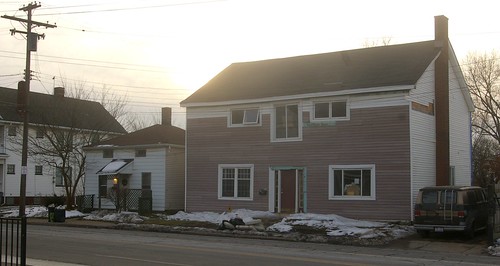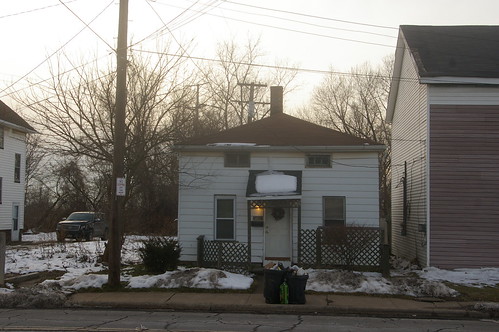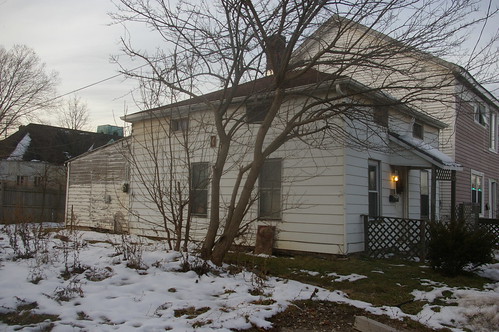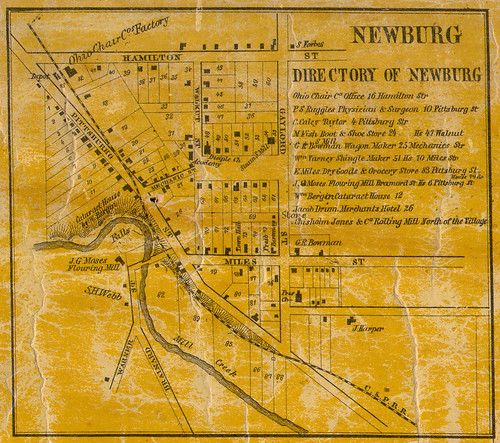
Do you sometimes miss something that's staring you right in the face? This pair of houses is an excellent example of that.

It began with the house on the left, 4216 East 93rd Street, built c. 1850 in the Greek Revival style. I came across the house thanks to a data set provided by John Strok of houses built before 1880, based on the County Auditor's information. If you've dealt with the property records, you know that dates given for houses are not always right, for a variety of reasons that can be addressed at a later time.
Small houses tend to either be demolished in favor of larger structures or remodeled and expanded until they no longer resemble the structure they began as. Further, houses on major roads tend to lose ground to businesses, which can make more profitable use of the space. For these reasons, it is unusual for this diminuitive, 600 square foot residence to still be around.

My first goal with this modest house was to determine how old it was. I wanted to believe that this was where it had been built. Roy Larick pointed out that it was not included in the 1858 Hopkins Map of Cuyahoga County.

The detail map of the village of Newburg, shown here, appears to probably include every residence or commercial building. This house would have been located on lot 76, on the southwest corner of Miles and Gaylord, just south of the rectangular building shown there.
The 1881 City Atlas of Cleveland, Ohio is the next one to show the buildings in detail. Note that the small structure on Miles on lot 76 has disappeared, and that a small building has appeared south of the rectangular one. It's worth pointing out that at this point, Gaylord became Woodland Hills, and that this map is oriented with east at the top.
I suspect that this small house was originally on Miles, as shown in the 1858 map, and was moved to the current location at sometime before 1881. The owner of the lot remained the same, so it seems most likely that he would have moved the structure on his own lot, likely for the purposes of commercial development. I suspect that the structure was originally some sort of commercial building, perhaps an office.
I don't have any further evidence to back this up. I am certain that a one story structure was located in the current location no later than 1881. Further, I'm certain that this house was built before 1858. I just lack the evidence to be sure that this was originally facing Miles Avenue.
Who built this house, and when? I haven't been able to answer that question. I haven't found an answer in the property transfer records. The business directory on the 1858 map doesn't provide any useful information. Even the ever-helpful Morgan Index of Ohio People, Businesses and Institutions, 1796-1850 fails to provide an answer.
The 1892 Atlas of Cuyahoga County and Cleveland, Ohio reveals the owner of the property to be one C.F. Christian. This provides something of a starting point.
The earliest record I've been able to find that corresponds to this is in the 1870 U.S. Census, which lists a Chas Christian, in Newburgh Township. Charles, a house carpenter, was born in New York in 1830. He had a wife, Lizzie (born 1830), and three children: Bertha (born 1854); Henry (born 1855); and Myra (born 1857). The 1880 U.S. Cenus lists their address as 2617 Woodland Hills Avenue, which doesn't correspond to any residence that I can place.
The 1896 Sanborn fire insurance map lists the larger house as 2030 Woodland Hills - but doesn't give an address for this house. The 1903 Sanborn map is the first where I've seen this house given its own address - 2034 Woodland Hills.
After the streets were renumbered, in 1905, the house became known as 4216 East 93rd Street. The larger house became known as 4212. It is at this address that we find Charles F. Christian living in 1910. Two other families were renting space in the house at the time as well. Another family, John and Ada McGraw, were renting 4216 East 93rd Street at the time. Charles F. Christian died in his house on February 28, 1919.
In short, while there's likely an interesting narrative behind this house, I have yet to find it.

This little house was probably built c. 1840-1850, though it could, if you wanted to be really optimistic, have been built a little earlier. It's one of very few remaining small wood-framed structures in the city that are this old. If it was, in fact, commercial, it might well be a unique example - very few of these structures remain.
I'd love to get down to the Cuyahoga County Archives and see if I could find a historic photo of this house. Perhaps it would reveal whatever detail lurks underneath the aluminum siding.
As it is, the only obvious historical detail is the small three pane window in the upper right in the photo. All of the second floor windows would probably have been of this design. While it would be common for larger houses to have the second floor windows even with those on the first floor, it was less common on smaller ones like this.
Though this building is a bit later, it reminds me of the Joshua Giddings law office, in Jefferson, Ohio.

I've missed a big part of this story - the larger house in my lead photograph, 4212 East 93rd Street. The vinyl siding and shape of the windows caused me to dismiss it initially - it stuck in my head as something built in the early 20th century and remodeled recently - it wasn't until someone else mentioned it that I considered the obvious - it was likely built in the 1850s, or perhaps a little bit earlier. The continual presence of it on the various maps should be seen as a clear indication of this.
I would guess, based on the proportions, that there would have been four windows across the front of the first floor of the house, and five across the second. It might have been of a similar style to the Spencer Warner residence.
Based on the size, I suspect that this building may have originally served as a tavern or inn. Perhaps future research will reveal this.




Totally amazing work Chris. You've unearthed a real piece of history.
ReplyDelete